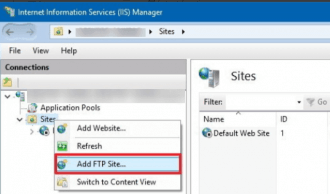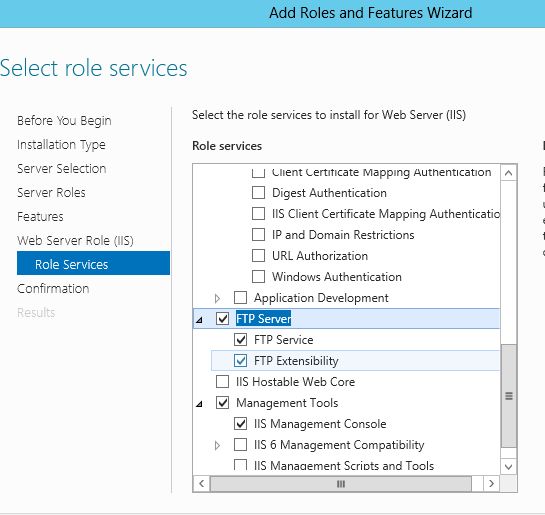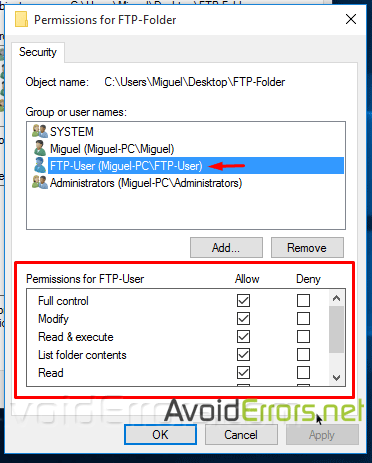

- #Windows 10 ftp server extensibility how to#
- #Windows 10 ftp server extensibility registration#
- #Windows 10 ftp server extensibility code#
- #Windows 10 ftp server extensibility windows#
At a minimum you must provide a name for your provider, but you will need to enter either the clsid for a COM-based provider or the type for a managed-code provider:
#Windows 10 ftp server extensibility registration#
Step 5 - When you click Add in the Actions pane, you can enter the registration information for your provider. By default you should see just the two built-in providers for the IisManagerAuth and AspNetAuth providers: Step 4 - If you click on the Collection row, an ellipsis will appear, and when you click that, IIS will display the Collection Editor dialog for FTP providers.

Step 3 - A default installation IIS with the FTP service should show a Count of 2 providers in the Collection row, and no settings in the activation row: Step 2 - Click the Section drop-down menu, expand the the system.ftpServer collection, and then highlight the providerDefinitions node: Step 1 - Open the IIS Manager and click on the Configuration Editor at feature the server level:
#Windows 10 ftp server extensibility how to#
With that in mind, in part 1 of this blog series, I will show you how to use the IIS Configuration Editor to add a custom FTP provider with provider-specific configuration settings. Here is an example from my nfig file for three custom FTP authentication providers the first two providers are installed with the FTP service, and the third provider is a custom provider that I created with a single provider-specific configuration setting: This feature was first available through the IIS Administration Pack for IIS 7.0, and is built-in for IIS 7.5 and IIS 8.0.īefore I continue, if would probably be prudent to take a look at the settings that we are trying to add, because these settings might help you to understand the rest of steps in this blog. That being said, there is actually a way to add custom FTP providers with settings like the ones that I have just described through the IIS interface by using the IIS Configuration Editor. This example adds a custom FTP provider, and then it adds a custom setting for that provider that is stored in your IIS configuration settings. Note: The file path that you specify in the xmlFileName attribute must match the path where you saved the "Users.xml" file on your computer in the earlier in this walkthrough.At the moment there is no user interface that enables you to add properties for custom authentication or authorization modules, so you will have to use the following command line:Īppcmd.exe set config -section:system.ftpServer/providerDefinitions /+"" /commit:apphostĪppcmd.exe set config -section:system.ftpServer/providerDefinitions /+"activation." /commit:apphostĪppcmd.exe set config -section:system.ftpServer/providerDefinitions /+"activation." /commit:apphost.Using the information from the previous steps, add the extensibility provider to the global list of FTP providers and configure the options for the provider:.Copy the Public Key Token value for example: 426f62526f636b73.Copy the Version number for example: 1.0.0.0.Copy the Culture value for example: Neutral.Right-click the assembly, and then click Properties.Locate the FtpXmlAuthorization assembly.
#Windows 10 ftp server extensibility windows#
In Windows Explorer, open your "C:\Windows\assembly" path, where C: is your operating system drive.Determine the assembly information for the extensibility provider:.
#Windows 10 ftp server extensibility code#
For example, if you take a look at my How to Use Managed Code (C#) to Create an FTP Authentication and Authorization Provider using an XML Database walkthrough, I include the following instructions: With this in mind, I include instructions in my blogs and walkthroughs that describe how to add those type of providers by using AppCmd.exe from a command line.

In addition, if you create a custom FTP provider that requires settings that are stored in your IIS configuration, there is no user interface to add or manage those settings. But if you are adding a custom home directory or logging provider, there is no dedicated user interface for adding those types of FTP providers. When you create a custom FTP authentication provider, IIS has a user interface for adding that provider to FTP. I've written a lot of walkthroughs and blog posts about creating custom FTP providers over the past several years, and I usually include instructions for adding these custom providers to IIS.


 0 kommentar(er)
0 kommentar(er)
